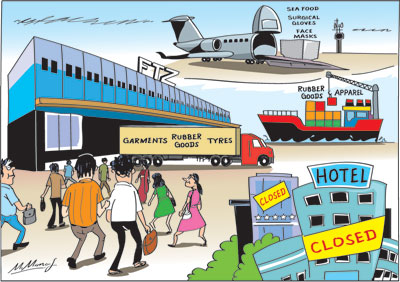Columns
Initial signs of economic recovery and revival
View(s): The Sri Lankan economy cannot recover until the global pandemic is contained and international trade recovers. Even achieving last year’s low level of output and growth is not possible without the resuscitation of international trade.
The Sri Lankan economy cannot recover until the global pandemic is contained and international trade recovers. Even achieving last year’s low level of output and growth is not possible without the resuscitation of international trade.
Signs of recovery
Nevertheless there are signs of economic recovery. Economic enterprises that are reviving would hopefully gain momentum and other economic activities too would commence production.
Least affected
It is also important that economic activities that were least affected by the corona virus shutdown perform to their full potential and contribute to increasing output, employment and incomes.
On the other hand, several key economic activities cannot be expected to revive even later this year. These include tourism and economic enterprises linked to tourism, construction and several export manufactures that face a depressed international demand.
Recovering manufactures
Over 200 enterprises in the Free Trade Zones (FTZs), employing over 30,000 workers, are reported to be currently in operation. These FTZ enterprises are in
Katunayake, Biyagama, Kandy, Seethawaka, Koggala, Horana and other FTZs. They are not operating at full capacity but expect to increase their production as the curfew restrictions are gradually lifted. However, their scale of operations could continue to be limited by international demand and disruption of supply chains.
 Optimistic
Optimistic
Several manufacturing industries are optimistic about their revival owing to a growth in international demand for their products or new items to which they can shift their production.
Apparel exports
Sri Lanka’s apparel export industry has new international orders. It also expects to gain by international purchasers shifting from buying Chinese garments. Furthermore, the apparel industry has also diversified into manufacturing protective masks and hygienic items whose demand has increased.
Rubber manufactures
Rubber manufactures are recovering by responding to changes in international demand. While Sri Lanka’s tyre manufacturing has had a setback due to a decline in demand for solid tyres for airplanes, there is a continuing demand for other types of solid tyres, such as for agricultural machinery. More significant is the massive demand for surgical and other rubber gloves.
Manufacture and export of these rubber products would make a significant contribution to export earnings. However, the low output of natural rubber could limit their production and export gains.
Sea food
Sri Lanka’s sea food exporters are expecting an unprecedented global demand owing many countries shifting from meat consumption to sea foods after COVID 19. As there is a shift in consumption from meats to fish in western markets, there is strong demand and higher prices for Sri Lanka’s seafood exports.
The traditional markets for sea food have been European countries, US and Japan. With the corona virus and the shift from meats to fish, the demand has shifted to frozen fish. The increased demand for sea food is from Europe, Japan. Middle East, China, US and even from badly infected Italy.
The constraints faced by the industry are limited air cargo facilities and high air freight rates as airlines are grounded worldwide. Air freight has increased three fold. Exporters have also faced payment difficulties.
New opportunities
Although deep sea fishing was not too badly affected by the shutdown, the sea food industry operated at less than a third of its production last year.This resurgence in the sea food exporting industry due to increased international demand is a new opportunity that must be seized. It is vital that these exports are not adversely affected by an European Union (EU) ban, as happened prior to 2015.
Tea
Tea exports have not been faring too well in recent years. Despite interruptions to tea sales and exports, there is currently a good demand for tea. Tea prices increased recently while tea export volumes too increased. This is in spite of an expectation of lower demand from Middle Eastern countries owing to the pandemic dislocation of trade and lower incomes in these countries owing to depressed incomes due to lower oil prices. It is important to ensure higher tea production to gain from this buoyant tea market.
Rice
Agriculture was the least affected by the economic disruption. The expectation was that food crops, especially paddy production, would be high. The Maha 2019-20 crop was a good one that ensured adequate rice till next year. The Yala 2020 harvest that was expected to dip somewhat owing to lesser rainfall, now appears would decrease even further as there is a fertilizer shortage.
Fertiliser shortage
It is vital that this fertilizer shortage is resolved and that farmers have adequate fertilizer in time. During the Presidential election campaign the two main parties promised free fertiliser. As it turned out, farmers are having difficulties in procuring fertiliser even at a price.
This problem needs to be resolved before the commencement of the next Maha cultivation in September/ October this year to ensure a good paddy harvest next year.
Tourism
Tourism that contributes about 10 percent to GDP is the worst affected economic enterprise. In 2018 tourism brought in US$ 4.4 billion. The Easter Sunday bombings setback tourism and in 2019 tourist earnings fell to US$ 3.5 billion. It is unlikely that tourism would bounce back.
Earnings from tourism woul fall precipitously. The significance of tourism for the economy does not lie only in the foreign exchange earnings. The setback to tourism and related activities has caused severe unemployment, loss of incomes and poverty. Unlike the 2019 setback that faded away after about 6 months, the global corona virus pandemic has put paid to international tourism in the foreseeable future. Furthermore, the prospect of domestic tourism supporting the tourist trade is not feasible till the pandemic is eliminated.
Remittances
In addition to these setbacks, the fall in revenue from remittances is a huge blow to the economy. In 2019 remittances of US$ 6.7 billion offset 80 percent of the year’s trade deficit of US$ 8 billion. Remittances too are likely to fall sharply.
The impact of this is not only on the balance of payments. It is the deprivation of incomes of a large number of poor households that depend on remittances for their survival. This humanitarian tragedy that has also been brought about by the loss of employment in several sectors of the economy, particularly tourism and related activities, is compounded by the decreased remittances.
Summary
The resumption of international demand and international supply chains is possible only once the pandemic is contained. Even then the international economy is not likely to reach the extents of trade and commerce of the pre-pandemic period owing to trade tensions, depressed demand and new policy outlooks.
The initial signs of Sri Lanka’s revival of export manufacturing, reorientation of exports to new international demands and enhancement of sea food exports and other exports that were not adversely affected are economic opportunities that must be seized and exploited to the full.
Conclusion
The initial signs of revival of export industries and sea food exports is heartening. However it is prudent to temper any optimism with caution as these gains in exports cannot offset the large losses in tourist earnings and remittances. While the glimmer of hope that some manufacturing industries and exports of sea food and tea may revive, tourism and related activities and the shortfall in remittances are severe loss of incomes of poor households. Behind the economic statistics of the slowdown is a vast humanitarian tragedy of poverty and unemployment.
Hopefully, the worldwide pandemic will be controlled early and the global economy revived to enable the trade tourist and remittance dependent Sri Lankan economy to be revitalized to ensure the growth of employment and incomes of people.



Leave a Reply
Post Comment